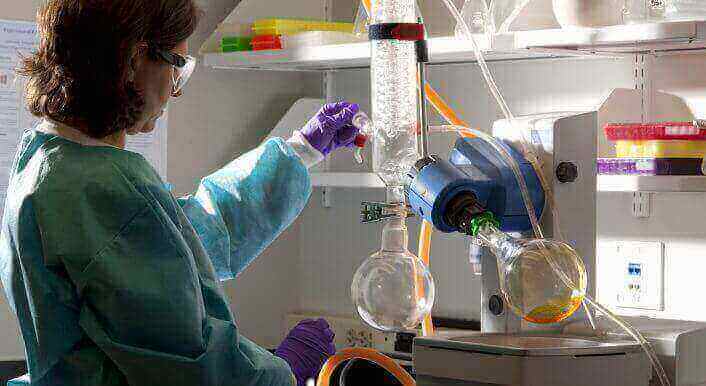Ten important moments in the history of antibiotic discovery
Starting in the 1930's, scientists began discovering antibiotics. These drugs have gone on to save millions of lives by killing the bugs responsible for infectious diseases. Here are the ten key moments in the discovery of antibiotics.

Alexander Fleming discovers penicillin 
Image credit: Monica Arellano-Ongpin licensed under Creative Commons
On September 3, 1928, Fleming returned from holiday and sorted through some petri dishes at St Mary’s Hospital in London, where he was Professor of Bacteriology. The dishes contained a bacteria called Staphylococcus, which causes boils, sore throats and abscesses. One dish stood out. It had a blob of mold on it, and the bacteria around the mold had been killed.
Fleming kept experimenting with his „mold juice“ and found it could kill a range of bacteria. He published the results of his research in 1929. Although it would be many years before penicillin could be isolated from the mold and used as an antibiotic, this marks the discovery of the first true antibiotic.
Source: The American Chemical Society
“Wonder drug“ penicillin developed for use on soldiers in World War Two 
A glass penicillin fermentation vessel like the ones used by drug company Glaxo between 1940-45 when attempting to mass-produce penicillin. Later, the mold was grown within large industrial fermenters and able to be mass produced. Image credit: Wellcome Images licensed under Creative Commons
After Alexander Fleming discovered it, penicillin largely fell out of scientists minds. It proved very difficult to isolate the drug from the mold. But the few trials that were carried out with it showed that it was hugely effective in treating infections, in mice at least.
With the outbreak of the Second World War, it became obvious that finding a way of mass producing penicillin could save many soldiers lives and be hugely useful. So the US and British government’s challenged the pharmaceutical industry to find a way to mass produce it.
Pharmaceutical companies chose different methods of trying to mass produce penicillin, but ultimately it was Pfizer that was successful – they developed a way of using deep-tank fermentation (a process they had been using to produce citric acid) to make penicillin in bulk. In 2008, Pfizer’s work on this was designated a National Historic Chemical Landmark by the American Chemical Society.
Once penicillin could be mass produced it was given to soldiers heading to Europe; because it was known that infections, not battle wounds, claimed more lives. Scientists manufactured 2.3 million doses of penicillin in time for the D-Day landings, and drug companies in the US distributed posters which proclaimed “Thanks to PENICILLIN… He Will Come Home!“
After the war, mass-production of the wonderdrug began in earnest and it was soon available to civilian patients.
Cephalosporins isolated in 1945
Image credit: Pablo Fernandez licensed under Creative Commons
Like penicillin, the class of antibiotics called cephalosporins came from research that was mostly academic, but then led to results which had a practical, medical application.
Cephalosporium bacteria was first isolated from soil in Sardinia, in 1945, by a scientist called Giuseppe Brotzu, who isolated the bacteria from sewage runoff. However, he lacked the resources to investigate further so sent samples to scientists at Oxford University, UK. The compound was then purified by Edward Abraham and Guy Newton.
After cephalosporin C, as it was called, was discovered in 1953 by the Oxford University scientists they sent it to the United States Further work in the United States led to large-scale production of the drug.
Cephalosporins are broad-spectrum antibiotics, which mean they are effective against a wide range of bacteria. They are used to treat septicaemia, pneumonia, meningitis, biliary-tract infections, peritonitis, and urinary-tract infections. Of the other antibiotics, they are most similar to the penicillins.
Sources: A Glimpse of the Early History of the Cephalosporins, Journal of Clinical Infectious Diseases, and NHS Evidence.
Chloramphenicol discovered in 1947 
Image credit: Brother Magneto licensed under Creative Commons
Chloramphenicol was discovered in soil and compost – a natural product secreted by the bacterium Streptomyces venezuelae. The efficiency of the new antibiotic was soon proved with dramatic results, combating two typhus outbreaks in Bolivia and Malaysia in 1948.
In 1949, chloramphenicol was approved for use by the US Food and Drug Administration as the first broad-spectrum antibiotic. Its use rapidly spread worldwide and it was used extensively in the treatment of infections ranging from acne to bronchitis to bacterial meningitis.
In the 1960’s, chloramphenicols popularity waned as use of the drug was linked to fatalities resulting from its toxic effects on bone marrow. It is now rarely used, due to its toxicity and the availability of effective, alternate antibiotics.
Source: The Journal of Pediatric Pharmacology and Therapeutics
1948: The first tetracyclines
Image credit: rchappo2002 licensed under Creative Commons
Discovered as natural products from the soil bacteria actinomycete, research on tetracyclines was first published in 1948. This new class of antibiotic was noted for their broad spectrum activity – they were effective against a wide range of infections – and they began to be mass produced in the late 1940’s and early 1950’s.
Source: New York Academy of Sciences
Discovery of colistin
Image credit: Nathan Reading licensed under Creative Commons
Bacteria are tested for sensitivity to antibiotics. This strain of bacteria was only resistant to Colistin, eg. it was resistant to all other antibiotics tested on it.
In 1947 an antibiotic called Polymyxin, in the class of antibiotics called the cyclic polypeptide antibiotics, was discovered. Polymyxin E was produced by soil bacteria, and is also called Colistin – because the soil bacteria that produces it was first called Bacillus polymyxa var. Colistinus, before being renamed Paenibacillus polymyxa.
Colistin has been available since 1959 for treating infections caused by Gram-negative bacteria. However, because it was potentially toxic – and another class of antibiotics, called aminoglycosides, were discovered which worked on the same bacteria but were less toxic – use in humans was massively restricted.
Colistin is now considered a drug of last resort, and is usually reserved to treat bacteria which are already resistant to treatment with other drugs. However, it’s been used to treat farm animals around the world for decades, and resistance to the drug has grown.
Sources: UK Government’s Animal and Plant Health Agency
Aminoglycosides
Image credit: Sanofi Pasteur licensed under Creative Commons. Scanning electron microscope image of mycobacterium tuberculosis, responsible for tuberculosis.
The first aminoglycoside, the antibiotic streptomycin, was discovered in 1943 by American biochemists Selman Waksman, Albert Schatz, and Elizabeth Bugie. They isolated the antibiotic from Streptomyces griseus, a strain of soil bacteria. Streptomycin was found to kill various bugs, including one which causes tuberculosis.
Aminoglycosides were the long sought after remedy to tuberculosis and other serious bacterial infections. However, their potential side effects – they could be toxic to kidneys and ears – meant their use declined in most countries in the 1970s and 1980s, as new antibiotics were discovered which could be used for similar treatment.
Today aminoglycosides are once more one of the most commonly used antibiotics worldwide, because of their high efficiency and low cost. Doctors may be reluctant to use them because of the risk of toxicity, but have little choice because these antibiotics are so powerful.
Source: US National Library of Medicine National Institutes of Health
The 1950’s: Discovery of macrolides
Image credit: Nathan Reading licensed under Creative Commons
The macrolides were first discovered in the 1950s, when scientists isolated erythromycin from the soil bacteria Streptomyces erythraeus. In the 1970s and 1980s synthetic versions of erythromycin, including clarithromycin and azithromycin, were developed.
Macrolides are used to treat infections caused by the bacteria Streptococcus in people who are allergic to and so can’t be treated with penicillin. Macrolides can also be used to treat penicillin-resistant strains of bacteria.
This family of antibiotics includes erythromycin and clarithromycin, which are particularly useful for treating lung and chest infections. Macrolides are well tolerated, orally available and widely used to treat mild-to-moderate infections.
Source: Encyclopædia Britannica
The emergence of MRSA
Image credit: NIAID licensed under Creative Commons. Scanning electron micrograph of a human neutrophil ingesting MRSA (purple).
Methicillin-resistant S. aureus was first reported in the UK in 1961, just a year after the antibiotic methicillin was introduced in the country. S. aureus was already resistant to penicillin, and when the bug became resistant to methicillin as well it became the first superbug – a bacteria that is resistant to multiple antibiotics.
MRSA remained uncommon in the UK for several years after it was first discovered, but then slowly the number of cases increased. In the 2000’s there were several outbreaks of MRSA infections in UK hospitals, causing thousands of deaths.
It’s hard to put a figure on how many cases of MRSA there are globally, and how many deaths. But in the US alone the Centers for Disease Control and Prevention estimates there are more than 80,000 invasive MRSA infections and over 11,000 deaths every year.
Source: Journal of Antimicrobial Chemotherapy
The quinolones – not isolated from soil but made by chemists
Image credit: Marc Perkins licensed under Creative Commons. A slide of gram-stained Bacillus megaterium seen at approximately 1,000x magnification. This bacterium is a gram-positive bacillus that is in the streptobacillus form (growing in long chains).
Unlike many of the other antibiotics discovered during the middle of the last century, the quinolone class of antibiotics was not isolated from bacteria in the soil but made, synthetically, by chemists.
The discovery of the quinolones began accidentally, in 1962, as a byproduct of some research on the antimalarial drug chloroquine. The accidental discovery led to prolific research on quinolones and the development of a library quinolone compounds.
The quinolones are a very useful class of antibiotics which can be used against both gram positive and gram negative bacteria.
Source: The Quinolones: Past, Present, and Future, Journal of Clinical Infectious Diseases



